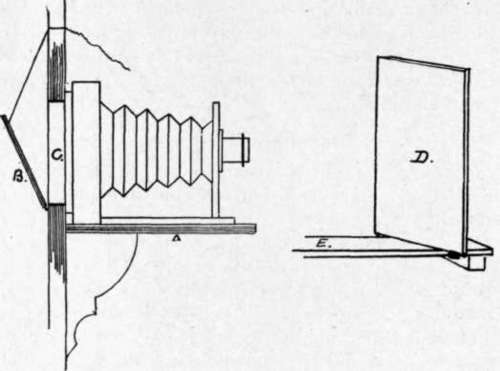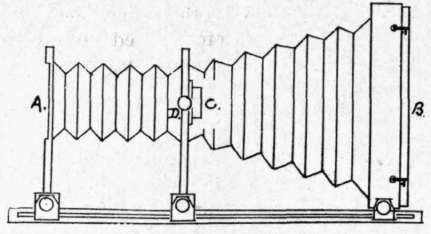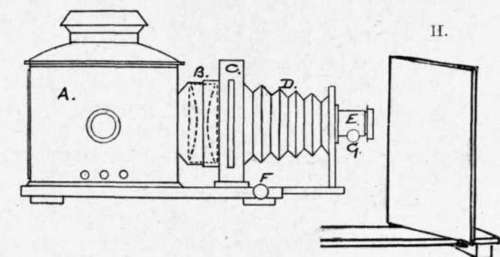Chapter XIII. Enlargement Making
Description
This section is from the "First Steps In Photography" book, by J. C. H. Wallsgrove. Also see Amazon: First Steps In Photography.
Chapter XIII. Enlargement Making
By Daylight - By Artificial Light - Transparencies
This may be done in one or two ways, either by daylight or artificial. The enlargement may be made either from a small negative direct upon bromide paper, or by making an enlarged negative and printing in the ordinary way upon any of the papers, as P.O.P., Platinum, Carbon, etc.
Daylight Methods
This is carried out by means of an ordinary camera in the dark-room, or in a properly constructed enlarging camera.
By The Ordinary Camera
This is within the reach of anyone who possesses a camera with bellows and preferably a lens of short focal length (about 6 inches). By reference to "Daylight as the Source of Illumination for the Dark-room" it will be found that mention was made regarding the position of the frame, A, Fig. 30, in the window-shutter, if there were likely to arise at any time a desire to make enlargements by daylight. A ledge is necessary to support the camera exactly in front of the window-shutter opening; as this ledge must be attached to the framework, it will, to a certain extent, regulate the position of the opening. If the opening in the window-shutter is larger than the negative from which the enlargement is to be made, the negative must be supported in a carrier. This is a second frame of thin wood having an opening, into the rebated portion of which the negative will exactly fit. Fig. 48 shows a side-view of the arrangement of the camera and surroundings placed ready for making an enlargement. A is the ledge to support the camera, which, after removing the back, must be pushed up to cover the opening C, in which the negative has been placed with the film side into the room. If any stray light should make its appearance between the opening and the camera, it must be shut out by wrapping the dark-cloth round. B is a reflector of white cardboard carried on wood hinged to the window-shutter, that it may be manipulated from inside by means of a piece of string. This reflector is to catch the light from the sky and throw it back through the negative, otherwise uneven illumination will result, and a portion of the sensitive paper will be over-exposed and the other under-exposed. The image from the negative, after passing through the camera, will be received on the easel, D, upon which a piece of white paper has been pinned. The support, E, may be either a continuation of the ledge, A, or a separate piece. The camera and easel must be held firmly in position by some means or other after the focussing has been done, also the reflector moved up and down to ascertain if the best possible illumination has been obtained.

Fig. 48.
Focussing
The following applies to all the enlarging apparatus. When a lens is equidistant between the negative and the easel and the focus has been obtained, the image will be equal in size in both cases. This should be remembered when wishing to copy a photograph. When the lens is brought nearer to the negative, it will be found that the easel must be placed farther away and the image will be increased in size.
The Exposure
This will depend entirely upon the quality of light prevailing at the time. Trial-exposures on a slip of bromide paper are recommended. The lens must be closed: then fasten a strip of fast bromide paper down the easel; this should be covered with a piece of brown paper. When an enlarging apparatus is used the trial strip is placed in the dark-slide. Uncover a third part of it, and give half a minute exposure; uncover another third part, and give a further half-minute, and then remove the covering entirely, and expose for half a minute again; this will then represent, half, one, and one and a half minutes' exposure. The exposed paper is then developed in a normal hydroquinone or other suitable developer. The times given above are merely suggestive; a correct exposure may be obtained in less time, or it may require longer. When the correct time has been ascertained, the large sheet of sensitive paper is put in position, the exposure made, and the development, etc., carried out exactly as for ordinary bromide paper.

Fig. 49.
The Daylight-Enlarging Camera
In this the same principle is involved, only, being self-contained, no window arrangement is necessary. Fig. 49 represents a section of the apparatus. It consists of two chambers, one large and one small. The negative is placed in the opening at the end of the small one at A; the end B of the large one is provided with a ground-glass movable focussing screen, which is replaced by a dark-slide containing the bromide paper. The lens C is attached to the middle support. It should be provided with a shutter working close to it, and operated by the milled-edge screw, D, from the outside. The work - with the exception of filling the dark-slide - should be done preferably in the open, where the negative may get an uninterrupted and even light from the sky, by tilting the enlarger at the time of the exposure. The focussing is done by moving the various parts about until the image is quite clear. This operation may be materially helped by having a piece of white card placed at an angle to the negative; the image on the focussing screen will then be better seen. The same experimental exposures as suggested above should be made before putting the large sheet of bromide paper into the dark-slide.

Fig. 50.
Continue to:


